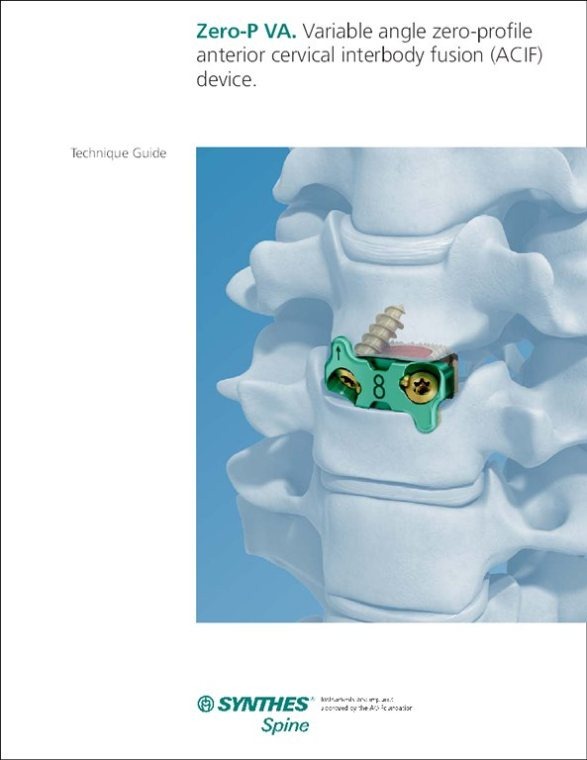Oct 24 2012
DePuy Synthes Spine today announced the launch of the ACIS Anterior Cervical Interbody Spacer System (ACIS System), a comprehensive set of spacers and instrumentation for anterior cervical discectomy and fusion (ACDF).

The announcement was made here at the North American Spine Society (NASS) 27 annual meeting, where the company is featuring the ACIS System alongside the ZERO-P VA, a new zero-profile stand-alone two variable angle screw construct for ACDF that was launched earlier this year.
“Each of these new systems addresses different surgical and clinical needs of patients with degenerative disc disease in the cervical spine, a major focus of innovation for us,” said Namal Nawana, Worldwide President, DePuy Synthes Spine.
ACIS System spacers are offered in three axial footprints (12.5mm, 14mm or 16mm widths), eight heights (5mm – 12 mm) and three sagittal profiles (lordotic, parallel or convex) to accommodate individual patient anatomy and surgical techniques. The spacers are made of PEEK*OPTIMA radiolucent material and features a large axial lumen to maximize the area for packing autogenous bone graft and enable fusion to occur through the spacer. Accompanying instrumentation streamlines the ACDF procedure. The ACIS System is intended to be used with supplemental fixation.
"The ACIS System is very comprehensive and user friendly, especially with the shorter instruments, which are easier to use under the scope. The three different spacer sizes provide a good option for all patients and all levels. The larger lumen and the ability to insert large amounts of graft material is very important for adequate fusion and stability," said Ali Chahlavi, MD,** a neurosurgeon at St. Vincent's Medical Center in Jacksonville, Florida.
ZERO-P VA is the newest addition to the ZERO-P family of implants, stand-alone devices that combine the functionality of a cervical interbody spacer with the benefits of an anterior cervical plate. (1-4) The new implant, which is available in three sagittal profiles, features a two-variable-angle-screw and a one-step screw securing mechanism. Another version, the ZERO-P, features a four-screw rigid locking construct. The devices come pre-assembled with a spacer made from PEEK* OPTIMA and a titanium alloy interbody plate.
Unlike traditional anterior cervical plates, ZERO-P family of implants are placed in the disc space with minimal to zero protrusion beyond the anterior surface of the vertebral body designed to minimize contact with local anatomical structures and prevent contact with adjacent levels. In addition, because of the pre-assembly of the plate and spacer, the plate is automatically aligned upon insertion of the implant.
The ACIS System and ZERO-P VA are part of DePuy Synthes Spine's extensive portfolio of cervical fusion and arthroplasty devices and solutions including CAM-LOC Active-Locking Plate System, SKYLINE Anterior Cervical Plate System, UNIPLATE 2 Anterior Cervical Plate System, VECTRA Anterior Cervical Plate System, ZERO-P Zero-Profile Anterior Cervical Interbody Fusion System, SYNAPSE OCT Spinal System, MOUNTAINEER OCT Spinal System and PRODISC -C Total Disc Replacement System.
About DePuy Synthes Spine
DePuy Synthes Spine has one of the largest and most diverse portfolios of products and services in spinal care and is a global leader in traditional and minimally invasive spine treatment. The company offers procedural solutions for the full spectrum of spinal disorders including adult and adolescent deformity, spinal stenosis, trauma and degenerative disc disease. DePuy Synthes Spine is part of DePuy Synthes Companies of Johnson & Johnson, the largest provider of orthopaedic and neurological solutions in the world. For more information visit, www.depuysynthes.com.
References
*Polyetheretherketone
** Dr. Chahlavi is a paid consultant to DePuy Synthes Spine
-
Kaiser MG, Haid RW Jr., Subach BR et al. (2002) Anteriorcervical plating enhances arthrodesis after discectomy andfusion with
cortical allograft. Neurosurgery. 50:229–236.
-
Caspar W, Geisler FH, Pitzen T et al. (1998) Anterior cervicalplate stabilization in one- and two-level degenerativedisease:
overtreatment or benefit? J.Spinal Disord. 11:1–11.
-
Mobbs RJ, Rao P, Chandran NK (2007) Anterior cervical discectomy and fusion: analysis of surgical outcome with and without
plating. J.Clin.Neurosci. 14:639–6342.
-
Moftakhar R, Trost GR (2004) Anterior cervical plates: a historical perspective. Neurosurg.Focus. 16:E8